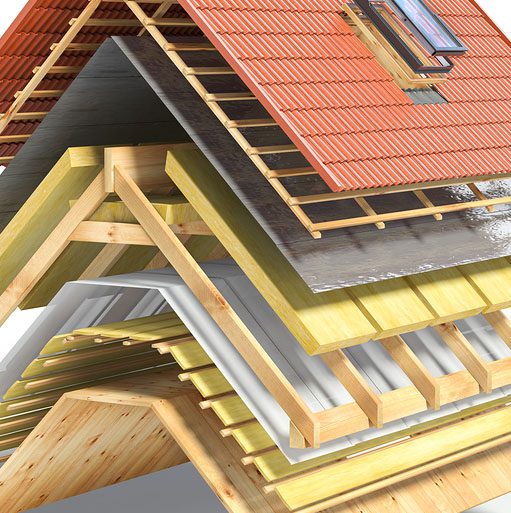Attic insulation and ventilation may not sound like important parts of your roof system, but these two features directly affect how your roof functions and performs in a variety of situations. The ventilation and insulation beneath your roof’s surface affect both cold weather performance and hot weather performance, as well as what happens to your roof in high humidity.
Here’s how and why attic insulation and ventilation are so crucial to your roof in different types of weather.
Cold Weather
You probably know that attic insulation improves energy efficiency in cold weather by keeping warm air in and reducing your heating bills. But insulation and ventilation are also vital to preventing ice dam leaks.
Ice damming occurs when snow starts to melt against the roof surface, then runs down to and freezes on the eaves because the overhang isn’t heated from beneath. This forms a dam so when more snow melts against the surface, the water is held in place and seeps through the roof.
You can reduce ice dam damage by installing an ice and water shield under the shingles. But to tackle the source of the damage, remove the heat that melts the snow. Improve insulation and ventilation to greatly reduce the chances of ice dam formation by keeping heat inside your home where it belongs.
Improving attic insulation doesn’t just mean adding another layer to the floor. If you already have plenty of attic insulation, be sure you check for attic bypasses, which may also need to be filled in and insulated. And any venting or heating ducts need to be insulated or they could leak heat into the attic as well.
Ventilation helps by allowing cold outside air to sweep across the underside of the roof, chilling it, while helping any heat in the attic to rise up through ridge or gable vents, providing an additional assist to keep the roof cool. Check your vents; if they’re unblocked and free of cobwebs but you still have ice dams, you may need more vents.
Hot Weather
Winter isn’t the only time you need great roof ventilation and insulation. Ventilation is especially beneficial for your roof’s performance in hot weather. For one thing, a poorly ventilated roof will build up a lot of heat under the roof deck due to the intense sunlight that hits it. If this heat can’t escape effectively, the shingles can deteriorate.
Another issue is that when heat builds up under the roof, it can then transfer through the attic floor into your living area. This problem can be especially drastic if your attic insulation is also lacking. Unwanted heat buildup during hot weather means your AC system has to work harder and costs you money on your energy bills, which makes your home less efficient.
If, on the other hand, your attic is well-insulated and well-ventilated, excess heat can more easily escape before transferring into your home.
Damp or Humid Weather
Although it does have dry air during some months of the year, the Toledo area often experiences muggy conditions with high humidity on a regular basis. Your attic ventilation can greatly affect what happens to your roof during periods of high humidity.
When your roof’s surface cools down at night, the humid air underneath can form condensation on the roof deck. This condensation can run down the roof deck and cause water damage, or it can foster mold growth on your roof deck. Improve the roof ventilation to help reduce or prevent condensation buildup.
Our roofing services in Toledo, Ohio, include not only re-roofing and roof repair, but also roof insulation and ventilation as well as other services that fall under the category of home repair.
Whether you just want to prevent ice dams or whether you want to give your entire home an eco-friendly makeover, get in touch with Seagate Roofing and Foundations today.

